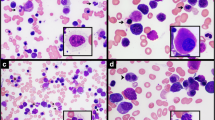Abstract
We report a case of acute myelogenous leukemia (AML) withMLL (myeloid-lymphoid leukemia or mixed-lineage leukemia) gene rearrangement after exposure to tegafur/uracil. Cytogenetic and clinical findings in this patient: t(11;17) (q23;q25), AML-M4 morphology, development of AML within a short latent period after first exposure to tegafur/uracil, and good response to remission induction chemotherapy but short remission duration, have been considered typical features of therapy-related acute myelogenous leukemia (t-AML) after exposure to topoisomerase II—targeting agents. This case report suggests that t-AML may develop after exposure to tegafur/uracil and thatMLL gene rearrangement may not necessarily be specific to t-AML after exposure to topoisomerase II—targeting agents.
Similar content being viewed by others
Referencess
Le Beau MM, Albain KS, Larson RA, et al. Clinical and cytogenetic correlations in 63 patients with therapy-related myelodysplastic syndromes and acute nonlymphocytic leukemia: further evidence for characteristic abnormalities of chromosomes no. 5 and 7.J Clin Oncol. 1986;4:325–345.
Pedersen-Bjergaard J, Pedersen M, Roulston D, Philip P. Different genetic pathways in leukemogenesis for patients presenting with therapy-related myelodysplasia and therapy-related acute myeloid leukemia.Blood. 1995;86:3542–3552.
Pedersen-Bjergaard J, Philip P, Larsen SO, et al. Therapy-related myelodysplasia and acute myeloid leukemia. Cytogenetic characteristics of 115 consecutive cases and risk in seven cohorts of patients treated intensively for malignant diseases in the Copenhagen series.Leukemia. 1993;7:1975–1986.
Gill Super HJ, McCabe NR, Thirman MJ, et al. Rearrangements of the MLL gene in therapy-related acute myeloid leukemia in patients previously treated with agents targeting DNA-topoisomerase II.Blood. 1993;82:3705–3711.
Ratain MJ, Kaminer LS, Bitran JD, et al. Acute nonlymphocytic leukemia following etoposide and cisplatin combination chemotherapy for advanced non-small-cell carcinoma of the lung.Blood. 1987;70:1412–1417.
Ratain MJ, Rowley JD. Therapy-related acute myeloid leukemia secondary to inhibitors of topoisomerase II: from the bedside to the target genes.Ann Oncol. 1992;3:107–111.
Nakajima T. Review of adjuvant chemotherapy for gastric cancer.World J Surg. 1995;19:570–574.
Wada H, Hitomi S, Teramatsu T. Adjuvant chemotherapy after complete resection in non-small-cell lung cancer. West Japan Study Group for Lung Cancer Surgery.J Clin Oncol. 1996;14:1048–1054.
Carver JH, Hatch FT, Branscomb EW. Estimating maximum limits to mutagenic potency from cytotoxic potency.Nature. 1979;279:154–156.
Grimwade D, Walker H, Oliver F, et al. The importance of diagnostic cytogenetics on outcome in AML: analysis of 1,612 patients entered into the MRC AML 10 trial.Blood. 1998;92:2322–2333.
Bower M, Parry P, Carter M, et al. Prevalence and clinical correlations of MLL gene rearrangements in AML-M4/M5.Blood. 1994;84:3776–3780.
Tien HF, Hsiao CH, Tang JL, et al. Characterization of acute myeloid leukemia with MLL rearrangements—no increase in the incidence of coexpression of lymphoid-associated antigens on leukemic blasts.Leukemia. 2000;14:1025–1030.
Takeyama K, Seto M, Uike N, et al. Therapy-related leukemia and myelodysplastic syndrome: a large-scale Japanese study of clinical and cytogenetic features as well as prognostic factors.Int J Hematol. 2000;71:144–152.
Turker A, Guler N. Therapy related acute myeloid leukemia after exposure to 5-fluorouracil: a case report.Hematol Cell Ther. 1999;41:195–196.
Shimano S, Murayama K, Katahira H, Tsuchiya J. A retrospective study of acute myelogenous leukemia and myelodysplastic syndrome cases—clinical and hematological findings [in Japanese].Jpn J Cancer Clin. 1994;40:175–179.
Komatsu T, Yamazaki H, Shimada N, Nakajima M, Yokoi T. Roles of cytochromes P450 1A2, 2A6, and 2C8 in 5-fluorouracil formation from tegafur, an anticancer prodrug, in human liver micro-somes.Drug Metab Dispos. 2000;28:1457–1463.
Heidelberger C, Danenberg PV, Moran RG. Fluorinated pyrimidines and their nucleosides.Adv Enzymol Relat Areas Mol Biol. 1983;54:58–119.
Maraschin J, Dutrillaux B, Aurias A. Chromosome aberrations induced by etoposide (VP-16) are not random.Int J Cancer. 1990;46:808–812.
Broeker PLS, Super HG, Thirman MJ et al. Distribution of 11q23 breakpoints within the MLL breakpoint cluster region in de novo acute leukemia and in treatment-related acute myeloid leukemia: correlation with scaffold attachment regions and topoisomerase II consensus binding sites.Blood. 1996;87:1912–1922.
Liu LF. DNA topoisomerase poisons as antitumor drugs.Annu Rev Biochem. 1989;58:351–375.
Pommier Y, Zwelling LA, Kao-Shan CS, Whang-Peng J, Bradley MO. Correlations between intercalator-induced DNA strand breaks and sister chromatid exchanges, mutations, and cytotoxicity in Chinese hamster cells.Cancer Res. 1985;45:3143–3149.
Krynetskaia NF, Cai X, Nitiss JL, Krynetski EY, Relling MV. Thioguanine substitution alters DNA cleavage mediated by topoisomerase II.FASEB J. 2000;14:2339–2344.
Osaka M, Rowley JD, Zeleznik-Le NJ. MSF (MLL septin-like fusion), a fusion partner gene of MLL, in a therapy-related acute myeloid leukemia with a t(11;17)(q23;q25).Proc Natl Acad Sci U S A. 1999;96:6428–6433.
Taki T, Ohnishi H, Shinohara K, et al. AF17q25, a putative septin family gene, fuses the MLL gene in acute myeloid leukemia with t(11;17)(q23;q25).Cancer Res. 1999;59:4261–4265.
Megonigal MD, Rappaport EF, Jones DH, et al. T(11;22) (q23;q11.2) in acute myeloid leukemia of infant twins fuses MLL with hCDCrel, a cell division cycle gene in the genomic region of deletion in DiGeorge and velocardiofacial syndromes.Proc Natl Acad Sci U S A. 1998;95:6413–6418.
Author information
Authors and Affiliations
Corresponding author
About this article
Cite this article
Fukushima, T., Yoshio, N., Noto, Y. et al. MLL Gene Rearrangement in Acute Myelogenous Leukemia After Exposure to Tegafur/Uracil. Int J Hematol 75, 178–181 (2002). https://doi.org/10.1007/BF02982024
Received:
Revised:
Accepted:
Published:
Issue Date:
DOI: https://doi.org/10.1007/BF02982024




